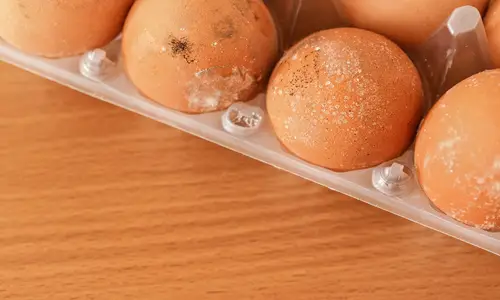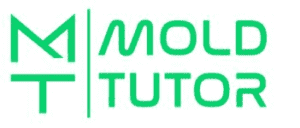There’s nothing more frustrating than opening a carton of eggs so you can create an excellent omelet for breakfast, only to find that your eggs have patches of what looks like mold on them. So, is it still safe to eat these eggs, or do you need to throw them out?
If mold is found growing on the shell of an egg, it should be discarded, as they are not safe to consume. As egg shells are porous, fungi can penetrate into the center, causing it to spoil. Consuming moldy eggs is known to lead to gastrointestinal issues and even food poisoning.
In this article we will be fully covering the topic of mold on eggs, answering whether or not they can still be consumed, and a whole bunch more, so keep reading!

Are eggs with mold on the shell safe to eat?
No, it is never advised to eat eggs that you have found are moldy, even if the mold only appears on the outer shell.
Despite the mold being on the outer layer of the shell, because an eggshell is porous, if the mold has been established on the egg for long enough, it may have already penetrated through the shell and into the egg itself. It is for this reason that washing mold off the shell will not render the eggs edible.
Mold can also be invisible to the naked eye whilst it is developing, so it is not worth the risk to assume once you have cleaned the egg that it is safe to eat.
If after opening a carton of eggs, you find that only one egg has mold growing on it, you may be tempted to throw away the moldy one and keep the rest. This is also not recommended, as spores can travel from the affected egg onto others, cross-contaminating them.
Additionally, eating an egg that has mold growing on it is likely to have a foul taste and highly unpleasant odor, so this is something you’d certainly want to avoid.
What happens if you eat moldy eggs?
Were you to eat an egg that has been infected with either bacteria or mold , you may experience gastrointestinal discomfort, and potentially even salmonella, which can cause diarrhea, vomiting, fever, and stomach cramps.
, you may experience gastrointestinal discomfort, and potentially even salmonella, which can cause diarrhea, vomiting, fever, and stomach cramps.
If you notice halfway through a meal that your egg has mold in it and you have only eaten a small amount, you may not suffer any serious issues at all. However, even a small amount of egg that contains salmonella bacteria can make you ill, so if you notice any of the above tell-tale signs of mold or bacteria growth, do not risk eating it, and do not finish the meal if you have already begun.
Why do eggs get moldy?
The main cause of mold growing on eggs is improper storage. Poor temperature control and excessive humidity levels during either the storage or transportation stages will create the perfect opportunity for mold to begin growing and spreading across a whole batch of freshly laid eggs.
Organic material left on the outer shell becomes its source of nutrition, and as they are often stored in the dark with very little airflow if the temperature is not controlled properly, mold has everything it needs.
Of course, there are strict rules enforced to make sure produce finds its way from the producer to your home in top condition, but these rules are not always met, and accidents can also happen, so whilst it’s uncommon to find a box of contaminated eggs, it does happen.
What do moldy eggs look like?
This is where things get a little more tricky. I am sure you have looked at a freshly purchased egg at some point and thought that it looks a little unclean, they even sometimes still have feathers on them.
This occurs more often in the U.K. where eggs are not washed before being sold , but even in the US, some bacteria and organic material can still be found, even if they appear clean to the naked eye.
, but even in the US, some bacteria and organic material can still be found, even if they appear clean to the naked eye.
The most common blemishes you’ll find, are small patches of a green, powdery substance. This is often a sign of fungal growth, but it can also come in black and white shades.
Here is a comparison table to help you decide whether your eggs are moldy or just need a rinse under the tap.
| Symptom | Action |
| White or brown feathers on shell | Common in the UK. No action is required, can be washed if felt necessary. |
| Brown or green dirt | Again common in the UK. Bacteria on the outer shell will often not harm the inner egg. Can again be washed. |
| Powdery green growth | Quite possibly mold growth, the egg should be discarded if uncertain. |
| Unpleasant smell | A poor odor indicates that eggs have been subject to fungal growth or have gone bad generally. The egg should be discarded. |
| Discolouration of shell | Perfectly natural mineral staining, this does not affect the egg and it is safe to eat. Mineral staining will not appear with a fluffy texture as mold does. |
| Spiderweb shaped patterns on the surface | Quite possibly an indication of mold growth, the egg should be discarded. |
| White chalky substance on shell | White chalky residue on the shell is perfectly harmless, this is a naturally occurring protective coating. If its appearance is fluffy or fuzzy, it may be white mold and it should be discarded. |
Is it definitely mold, or could it be something else?
To be certain that what you are seeing on your eggs is definitely mold growth, you should check for spiderweb-like growths of green, black, or white powdery substances.
The most common forms of mold found growing on eggshells are Penicillium , Alternaria
, Alternaria , and Rhizopus
, and Rhizopus , which can grow in partially circular patterns.
, which can grow in partially circular patterns.
However, what you think may be mold, could, in fact, be perfectly natural organic matter picked up from the enclosure the hens are kept in. Grit is added to the flooring of chicken coups to prevent them from eating their own feces, the eggs are laid onto the ground, and this grit and dirt can find their way onto the eggshell.
Ironically, much as buying dirty eggs may sound unpleasant, eggs have a natural coating (called the “bloom ”), which keeps air and bacteria from permeating the shell and contaminating its contents. If the shells are washed, this layer is removed and the eggs can quickly go bad.
”), which keeps air and bacteria from permeating the shell and contaminating its contents. If the shells are washed, this layer is removed and the eggs can quickly go bad.
One easy way to tell whether what you are dealing with is dirt or mold is to bring it close to a heat source. Once mold comes close enough to heat, the powdery structure will begin to deteriorate and give the appearance of melting, heat will have little to no effect on the dirt’s appearance.
This is far more common in the UK than in the US, as eggs are washed and cleaned in the States, whereas this is not the case in the United Kingdom. If you are in the States and do find signs of dirt on the shell of your eggs, you can still use the simple test described above to determine whether they are safe to use or not.
How to prevent eggs from becoming moldy
Finding your eggs have become moldy is a disappointment, to say the least, so in order to keep your eggs fresh for as long as possible, follow these tips on correct storage to prevent mold from forming.
- Store your eggs in a room with plenty of airflow
- For people outside of the US, keep your eggs at a temperature no higher than 40 degrees Fahrenheit

- For US readers, ensure your refrigerator thermostat is functioning correctly, and there is no damage to the gasket which could increase condensation and cause temperature fluctuations
- Inspect the shells for cracks or deep scratches, as these can be an entry point for bacteria and mold spores.
- Inspect the eggs once every few days to check for signs of growth or discoloration
- Use the eggs well within their “use by” date and do not keep them after this period.
Can eggs mold in the fridge?
Eggs can be stored at room temperature, and are often sold and stored this way throughout Europe. In the US, it is more common to store eggs in refrigerators. This is because of what was stated earlier about eggs in the US being washed which removes their natural protection against bacteria entering the inner egg.
Once an egg is put in a refrigerator, mold can indeed still begin to grow if there is adequate humidity and nutrients available. A fridge will generally have a fairly high humidity level, due to other foods being stored in it, and condensation caused by warm foods being placed into a cold environment.
If there is any malfunction of the refrigerator, such as a faulty thermostat or damaged gasket, the temperature the eggs are kept can become unstable. This mixture of high humidity coupled with varying temperatures can allow mold to begin to grow on eggshells. There are also some strains of mold that can still grow within refrigerated temperatures, so you should aim to use the eggs well within their use-by date and check them every few days.
Can hard-boiled eggs get moldy?
Yes, hard-boiled eggs will be more likely to grow moldy and at a faster rate than fresh eggs. This is because boiling the eggs removes the protective layer on the outer shell, allowing bacteria and mold spores to penetrate the shell.
A freshly boiled egg will last around seven days if it has not been peeled, but an egg without its shell will last no longer than 3 days before it begins to go bad.
if it has not been peeled, but an egg without its shell will last no longer than 3 days before it begins to go bad.
Bacteria are more likely to begin to grow in or around the egg than mold, but as mentioned previously, if the conditions are correct, mold will indeed be able to form on either a peeled or unpeeled boiled egg.
Can moldy eggs be saved?
Unfortunately not, if you discover any signs of mold either on the eggshell or within the egg once it’s been opened (such as black spots on the inside of the shell), they should be discarded.
Often, there will be a pungent smell accompanying the mold growth, which is a sure signal that you should not consume them.
Over to you
I hope this guide has given you some good guidance on the dangers of consuming moldy eggs and has also given you some great tips to prevent the issue from occurring again in the future. So, now I’d like to turn it over to you, have you ever accidentally eaten moldy eggs? Do you have any extra tips on how to spot the moldy ones from the fresh? If so, I’d love to hear about them in the comments below, or if you have any additional questions or anything you think I’ve missed, I’d be really pleased to add any extra info. Just leave me a comment below and I’ll get back to you.

